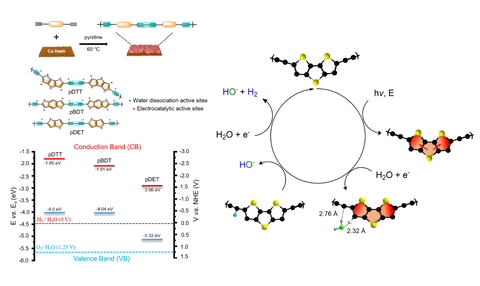15.07.2021
Dual Active Sites Conjugated Acetylenic Polymers for Photoelectrochemical Water Reduction in Alkaline Medium
Photoelectrochemical (PEC) water splitting is a promising technology for hydrogen production combining the inexhaustible solar energy and the electrolysis of water. A variety of inorganic materials including inorganic metal oxides, transition-metal dichalcogenides and metal sulphides have been reported as photocathodes materials; however, their need of co-catalysts, the high costs and the photocorrosion have been hindered their practical application.
Synthetic organic materials are emerging as an interesting class of photocathodes due to their intrinsic advantages over the inorganic counterparts. These include the broader absorption of the solar spectrum, the molecular tunability of band gaps and energy levels positions and the facile synthesis. So far, they have only been reported under acidic or neutral conditions, facilitated by the high concentration of protons; in alkaline medium, on the other hand, they still show poor performance due to the lack of water dissociation sites, which are needed to produce the required protons.
The researchers from the group of Prof. Xinliang Feng in collaboration with the group of prof. Inez Weidinger (TU Dresden) overcame this issue in the work Thiophene-based Conjugated Acetylenic Polymers with Dual Active Sites for Efficient Co-Catalyst-free Photoelectrochemical Water Reduction in Alkaline Medium, recently published in Angewandte Chemie.
Using a molecular engineering strategy, highly efficient active sites for water dissociation were incorporated in conjugated acetylenic polymers (CAPs) by modifying the polymer skeleton from poly(diethynylthieno[3,2-b]thiophene) (pDET) to poly(2,6-diethynylbenzo[1,2-b:4,5-b’]dithiophene (pBDT) and poly(diethynyldithieno[3,2-b:2’,3’-d]thiophene) (pDTT).
The as-synthesized pDTT and pBDT grown on Cu substrate demonstrated benchmark photocurrent densities of 170 mAcm-2 and 120 mAcm-2 (at 0.3 V vs. RHE; pH 13), which are 4.2 and 3 times higher than that of pDET.
Density Functional Theory (DFT) and electrochemical-operando resonance Raman spectroscopy reported that the Cβ of the outer thiophene rings are the water dissociation active sites, while the diacetylenic linkages function as electrocatalytic active sites. These findings will pave the way to design new and more efficient photocathodes.
Reference: Borrelli, C. J. Querebillo, D. L. Pastoetter, T. Wang, A. Milani, C. Casari, H. K. Ly, F. He, Y. Hou, C. Neumann, A. Turchanin, H. Sun, I. M. Weidinger, X. Feng, Thiophene-based Conjugated Acetylenic Polymers with Dual Active Sites for Efficient Co-Catalyst-free Photoelectrochemical Water Reduction in Alkaline Medium, Angew. Chem. Int. Ed. 2021, 60, 2–8, …/doi/10.1002/anie.202104469
Acknowledgments: This work was financially supported by the Graphene Flagship (GrapheneCore3, No. 881603) and ERC Grant (T2DCP, No. 819698). We acknowledge the cfaed (Center for Advancing Electronics Dresden) and the Dresden Center for Nanoanalysis (DCN) at TU Dresden. I.W. acknowledges the cluster of excellence UniSysCat (EXC 2008/1 -390540038). C.S. and A.M. acknowledge ERC Grant (CoG 2016 EspLORE, No. 724610). A.T. and C.N. acknowledge DFG TRR 234 “CataLight” (B7 and Z2) and research infrastructure grant INST 275/257‐1. M.B. thanks Dr. Tao Zhang, Huanhuan Shi, Dr. Markus Löffler (DCN), and Dr. Zhongquan Liao for preliminary characterization, Dr. Moritz Kuehnel and Dr. Uttam Gupta for preliminary measurements, Dr. Jian Zhang and Dr. Ahiud Morag for fruitful discussions and prof. Fabrizia Negri for preliminary calculations. C.J.Q. acknowledges Markus Göbel for his helpful suggestions.

